How Do I Upload Music to Itunes From My Ipod
Do y'all have an old iPod that's sitting effectually gathering dust? It might yet have music on it that you no longer possess in whatever other course. If that'southward the instance, grab your onetime music player, because you can transfer the music from your iPod to your computer.
To do so, you simply need to consider your iPod as an external drive that y'all can accept music from. In one case extracted from the iPod, y'all can add music to your iTunes or Apple tree Music library and fifty-fifty sync it with your iPhone. Nosotros'll show you how below.
Stride 1. Prevent iTunes From Automatically Syncing With Your Device
First, you'll need to brand certain you can transfer the music on your iPod without iTunes or the Music app erasing it while syncing.
When yous connect a device to iTunes or the Music app, the music in your library automatically syncs to your device. You cannot download music from an iPod (or iPhone or iPad) into iTunes or Music. So if you lot connect an iPod to your calculator, the music on the device will exist overwritten with what's in your iTunes or Music library.
The method for preventing iTunes from automatically syncing with your iOS device is by and large the same for Windows and Macs running Mojave or earlier:
- Make certain to disconnect all iOS devices from your estimator. Then, open up iTunes.
- In Windows, go to Edit > Preferences. On a Mac, go to iTunes > Preferences.
- On both platforms, click the Devices tab and check the Preclude iPods, iPhones, and iPads from syncing automatically box.
- Then click OK and close iTunes.
However, Macs running macOS Catalina and newer use Finder instead of iTunes to sync iOS devices. Because of this, you'll need to open your device in Finder and uncheck the Automatically sync when this iPhone is continued box.
Step 2. Copy Music From Your iPod to Your Reckoner
Now, you tin connect your iPod to your computer. It should show up as a drive both in File Explorer on Windows and Finder on a Mac. Open the iPod bulldoze and navigate to the iPod_Control > Music folder. Yous'll meet many folders labeled with an F and a number.
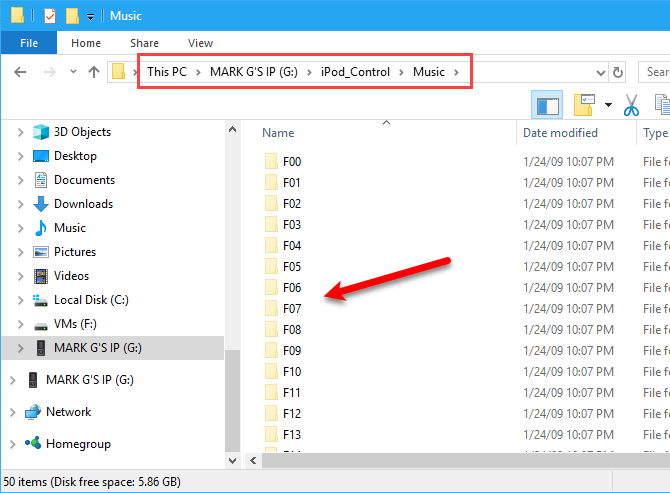
If your iPod drive appears empty, you demand to reveal hidden files and folders on your figurer.
Windows vii, viii, and 10 users tin showtime utilize Alt + Five to bring up the View tab. Afterward, printing the H primal two times to reveal hidden items. You can then either uncheck the Hidden items box or repeat the process to hide your files.
For those using macOS, agree down Cmd + Shift + Period to toggle hidden folders on or off. Select all the folders in the iPod_Control > Music folder and copy and paste them to a location on your hard bulldoze. This will transfer your music from your iPod to your figurer. The files all take random four-letter file names.
If you lot're using a Windows PC, you can come across the tags for each music file in File Explorer. You won't see the tags in Finder on a Mac. After, we'll testify you how to easily change the file names using the tags.
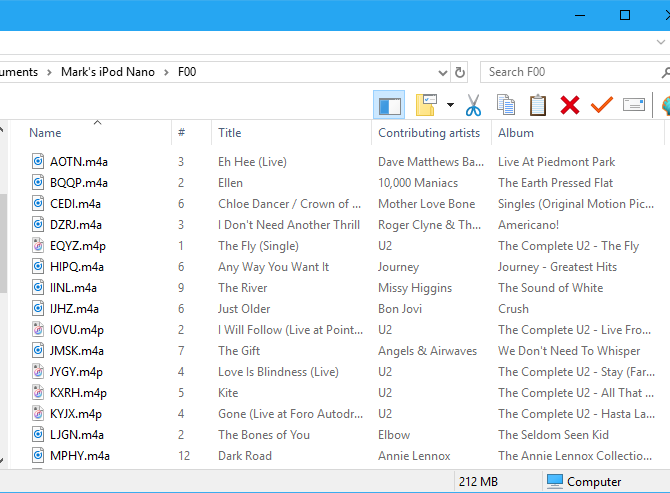
In one case you've copied the files, you can eject the iPod and disconnect it. On a Windows PC, right-click on the iPod drive in File Explorer and select Eject. Mac users should Command-click on the iPod icon on the desktop and select Eject.
If you don't want to apply iTunes or Apple Music, you lot tin besides try these tools to manage your MP3 collection.
Step 3. Add the Music to Your iTunes Library
After transferring the music from your iPod to your calculator, you tin can start making adjustments. First, add together the music from your iPod to your iTunes library on your Windows PC or Mac. Note that on macOS Catalina and newer, your music library appears in the Apple tree Music app since iTunes is gone.
By default, on Windows, adding items to your iTunes library creates a reference to the file'south current location. The original file remains in the current location. Thus, if you were to move the original files, iTunes would no longer encounter them.
You tin have iTunes for Windows brand a copy of each file and place them into the iTunes media folder. Moving the original files would then not affect the music in your iTunes library.
How to Centralize Your iTunes Music on Your Computer
Open iTunes for Windows and go to Edit > Preferences. Click the Avant-garde tab and check the Re-create files to iTunes Media folder when calculation to library box. This selection is checked past default in iTunes for Mac (on Mojave and earlier). Once enabled, all media added to your iTunes library from and then on will copy directly to the iTunes media folder.
Now yous won't have to worry about moving the original files anywhere else. Just recollect, media added to your iTunes library before enabling that checkbox yet links to the original media files.
How to Organize and Aggrandize Your iTunes Library
To organize your iTunes Media folder into artist and album folders, check the Keep iTunes Media binder organized box. Again, iTunes or the Music app for Mac enables this selection by default.
If yous take infinite, information technology'due south a good idea to copy all your media files to the iTunes Media binder. That way, they're all in i location and piece of cake to support.
To re-create the remaining media files linked to in your iTunes library, become to File > Library > Organize Library. On the Organize Library dialog box, check the Consolidate files box and click OK.
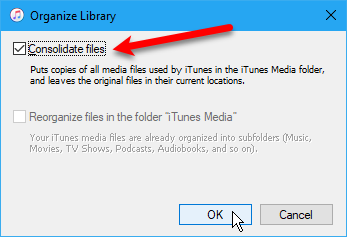
To add some or all of the music from your iPod to your iTunes library, go to either File > Add File to Library or File > Add Binder to Library in iTunes for Windows. If you lot're using a Mac, get to File > Add to Library. Then select the files or binder you want to add. You lot tin also add music to iTunes by dragging music files from File Explorer or Finder to the iTunes window.
If you need to change or gear up tags on your recently added music, yous tin do so directly in iTunes or the Music app. You lot tin change or fix tags for either a single vocal or multiple songs as needed.
Editing a Single Tag
To edit tags on Windows, right-click on the song and select Song Info. If using a Mac, agree Control and click to select Album Info.
In the dialog box that displays, you'll run into several tabs containing data about the selected song. You can edit items like the song title, artist, anthology, and genre. Click the buttons at the height to view and change the different information. To go to the next song in the listing, click the arrows at the bottom of the dialog box. When done editing the tags, click OK.
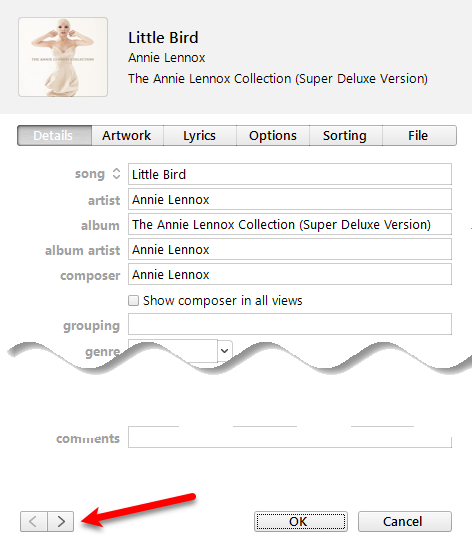
Editing Multiple Tags
You lot can also edit common information for multiple songs at the same time. Use the Shift or Ctrl (Cmd on Mac) keys to select the songs you desire to edit. Then right-click on the selected songs and select Get Info.
A confirmation dialog box displays. If you don't want to run into this dialog box every time, check the Practise not inquire me again box.
Click Edit Items to continue. Only the tags that employ to all the selected items display in the window. Click the buttons at the pinnacle to access the different types of data. Edit tags as you want and click OK.
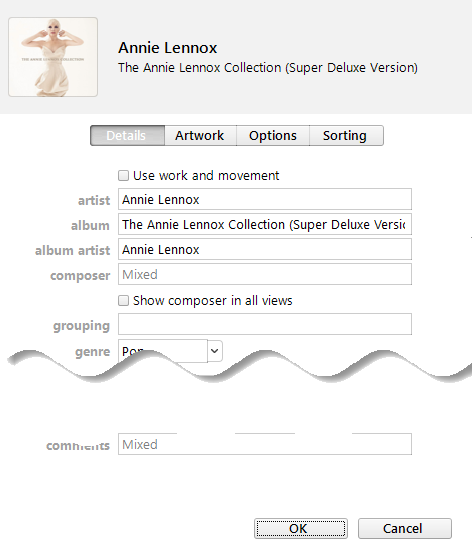
Step five. Create a Playlist in iTunes
If you utilise playlists on your iPhone, yous can create them in iTunes, and they'll sync to your iPhone. Whether using Mac or Windows, the process is the same. To create a playlist, select the songs you lot want in the playlist. And then correct-click on the selected songs and select Add together to Playlist > New Playlist.
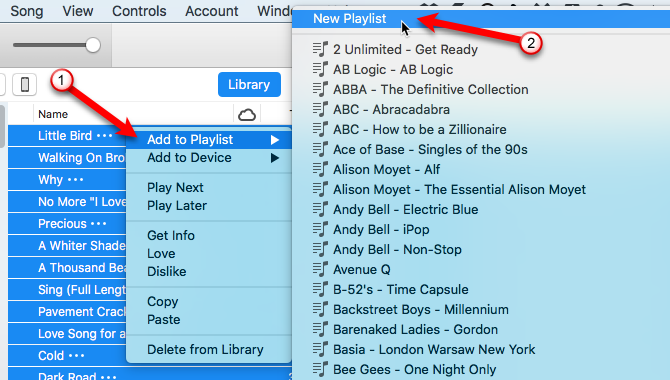
For like songs (such as an album), the playlist is created using artist and album title as the name. If you create a playlist from various songs, you'll need to enter a custom name. To alter the name of the playlist, click on the title and type a new title. You tin can besides rearrange the songs in the playlist by dragging and dropping them to different positions.
Step 6. Transfer Music to Your iPhone
To transfer the added music to your iPhone, brand sure iTunes or Finder is open up and connect your device to your calculator. Then click the device icon at the top of the iTunes window (or select the device in Finder on macOS Catalina and newer).
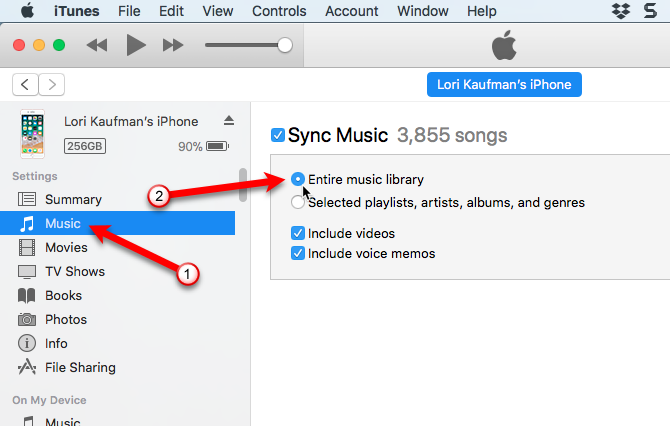
If you lot desire to quickly sync content to your iPhone, y'all can apply iTunes to sync your entire music library. Alternatively, if you only want to sync selected items, just the chosen playlists, artists, albums, and genres will sync.
In case you see a Replace and Sync message, remember that the iTunes library replaces everything on your iPhone.
To sync your entire library, click Music in the sidebar on the left nether Settings. So make certain to select Sync Music on the correct and select Entire music library. At present press the Apply button in the lower correct. If syncing doesn't brainstorm, you can press the Sync button.
Meanwhile, if you don't similar iTunes, bank check out the best music manager apps for iOS.
Pace vii. Rename the Music Files
One time you've transferred your old iPod music, you can rename the copied files. The random four-letter file names assigned to the files copied from your iPod aren't descriptive at all. On a Mac, you won't know what the songs are without adding them to iTunes or utilizing another app.
You tin can manually rename the files, merely there's an easier way using a gratuitous tool called Mp3tag. It's a Windows program, just Mac users tin can apply it via a workaround.
Rename Your Files With Mp3tag on Windows
On Windows, download Mp3tag and install it. To add Mp3tag to the File Explorer menu, check the Explorer Context Menu box on Choose Components screen during installation. To rename music files from your iPod, select the files in File Explorer. Then right-click on the files and select Mp3tag.
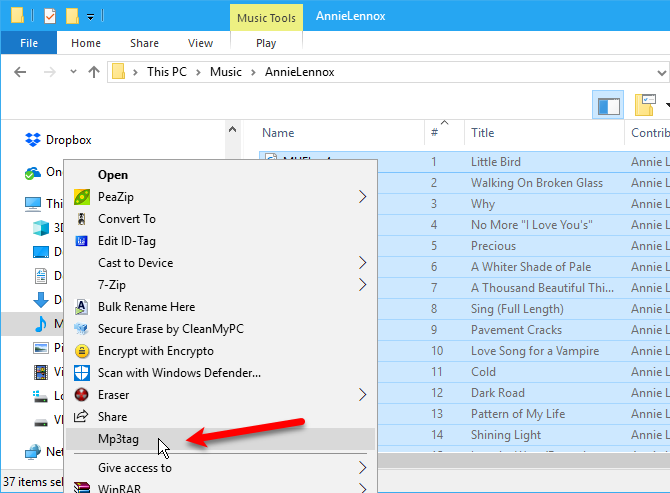
Within the programme, highlight your songs. Go to Convert > Tag - Filename or press Alt + 1. In the Tag - Filename dialog box, enter a Format string using placeholders to set upward your filename scheme. For example, look at the Format string in the epitome below. Information technology creates a file name with a two-digit track number, song title, artist name, and album name.
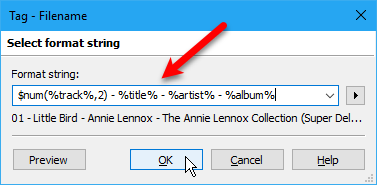
If you want to construct your own file name, you can use unlike format string placeholders available. Go to Help > Contents to get more info about them. After the transmission opens in your browser, click Renaming files based on tags under Working with tags and file names. You'll notice a list of placeholders you can apply in the Format string. Use these to create custom file names for your music files.
Alternatives and How to Utilise Mp3tag on Mac
There are music tagging apps for Mac like Kid3, but they aren't as easy to use as Mp3tag. If you accept macOS 10.xiv.6 Mojave or later, the developer of Mp3tag has a full version. Withal, Mac users either take to opt for a short-term trial or pay for the full app.
Yous tin download Mp3tag for Mac from the programmer website. If you choose to purchase the full version, it'll cost you lot $19.99.
After information technology'due south finished downloading, add it directly to the Applications folder on your Mac and run the prepackaged application. Use the aforementioned steps listed in a higher place to rename music files using Mp3tag on your Mac.
If this all seems too much, effort these alternatives to the Mac Music app and iTunes.
Breathing New Life: Transfer Music from an Old iPod to Your Computer
If your old iPod still charges enough to use, you tin can easily transfer music from that iPod to your computer. Afterwards transferring music from your iPod to iTunes or your iPhone, requite it a new purpose. Consider reusing your erstwhile iPod equally an eBook reader or a secondary music collection holder.
About The Author
Source: https://www.makeuseof.com/tag/transfer-music-ipod-computer/

0 Response to "How Do I Upload Music to Itunes From My Ipod"
Post a Comment